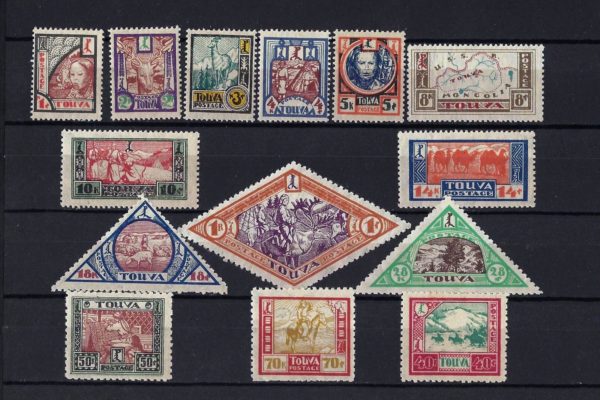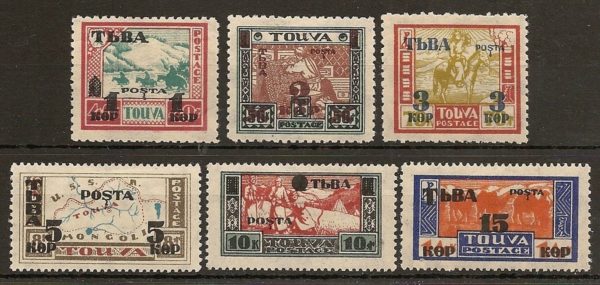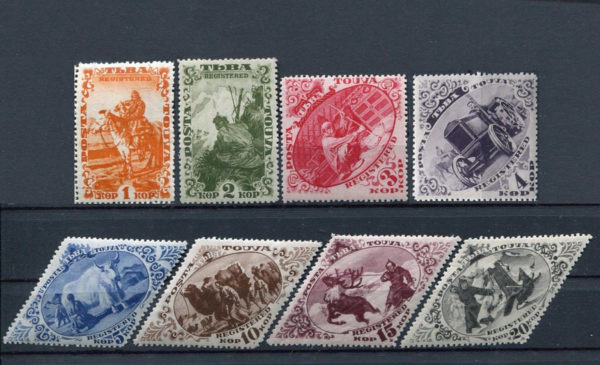The postage stamps and postal history of Tannu Tuva forms one of philately’s curious byways, featuring exotic and colorful stamps issued by an obscure country which held special fascination for young stamp collectors in the middle of the twentieth century.
Tannu Tuva
Tannu Tuva or formally the Tuvan People’s Republic was an autonomous region in central Asia between Russia and Mongolia, which in 1921, under Russian instigation, became the Tuvan People’s Republic. A treaty between the Soviet Union and the Mongolian People’s Republic in 1926 affirmed the country’s independence, although no other countries formally recognized it. In 1944, it became annexed to the Soviet Union as the part of the Tuvan Autonomous Oblast and in 1961 became the Tuva Autonomous Soviet Socialist Republic. It’s successor in 1992, the Tuvan Republic is a member of the Russian Federation.
The stamps
Between 1926 and 1933, Tannu Tuva issued a series of 38 postage stamps. The first series depicted the Buddhist wheel of life with Mongolian writing and without any western words. Beginning in 1927, Tannu Tuva issued a series of color stamps with local scenes or a map of the country. These stamps were issued in several shapes, including rectangles, triangles and diamonds, and bore text in Mongolian and the words “TOUVA” and “postage”.
Between 1934 and 1936, Tuva issued a series of postage stamps with exotic images of Tuvan life, including horse racing, nomadic battle scenes, and a camel apparently racing a locomotive. These stamps were large and came in a variety of sizes including diamonds, and were widely sold to collectors in cancelled to order form. They were printed in Russia by photogravure and, as such, resemble the contemporary stamps of the Soviet Union also sold cancelled to order to collectors. The Scott and Stanley Gibbons Catalogues do not recognize these as valid postage stamps, although some contend that they did see at least limited postal use.
During the 1940s and 50s, these exotic stamps were popular with young collectors. This is documented, for example, in Ralph Leighton’s Tuva or Bust!, Richard Feynman’s Last Journey (W.W.Norton 1991), which tells the story of famous physicist Richard Feynman whose childhood memories of the colorful stamps of Tannu Tuva inspired him and the author on a quest, first to contact someone in Tuva, and then to actually visit the country. (Feynman, unfortunately died before achieving their goal, but Leighton ultimately reached Tuva.) Leighton and Feynman’s efforts rekindled an interest in Tuva and its stamps, which now are the subject of numerous websites, such as The Friends of Tuva.
Catalog
To be continue..
The website is under development. Please bookmark us and visit later.
Where to buy
https://russianphilately.com/c/tannu-tuva – Tanny Tuva section at RussianPhilately.com.
Currency
1 Ruble = 100 kopeck (1921—1924);
1 Soviet Ruble = 100 kopeck (1924—1935);
1 tugrik = 100 mungu = 100 kopeck (1935—1936);
1 aksa = 100 kopeck (1936—1944)
The akşa was the currency of the Tuvan People’s Republic (Tannu-Tuva) between 1934 and 1944. It was subdivided into 100 kɵpejek (kopeck). Akşa in the Tuvan language (akça in many other Turkic languages) simply means “money”.
Prior to the introduction of the akşa, Tuva issued overprinted Russian and Soviet banknotes. The first series (issued in 1924) was overprinted with denominations in lan, with the number of lan equal to the face value of the (otherwise obsolete) Russian notes. The second series (issued 1933) carried overprints on Soviet notes in rubles and chervonets.
Coins were issued in 1934 in denominations of 1-, 2, 3-, 5-, 10-, 15 and 20 kɵpejek, a Tuvanized name for the Russian kopeck, with banknotes issued in 1935 and 1940 in denominations of 1 to 25 akşa.



